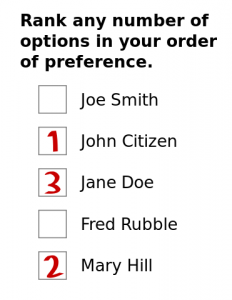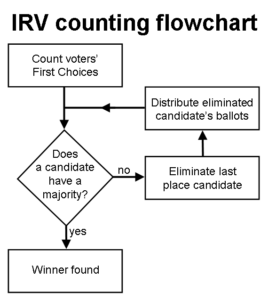 Ranked-choice voting is a method of voting in which the voters rank their options, giving their preference of first, second, third, fourth, etc. choice on their ballot. Depending on which ranked-choice method is used, the votes are tabulated in different ways based on the ranking of each ballot. In a traditional “first-past-the-post” (FPTP) system, the candidate with the most votes wins. If they do not receive a majority of the votes, in a two-round system (TRS), a separate run-off election is required at additional cost and effort.
Ranked-choice voting is a method of voting in which the voters rank their options, giving their preference of first, second, third, fourth, etc. choice on their ballot. Depending on which ranked-choice method is used, the votes are tabulated in different ways based on the ranking of each ballot. In a traditional “first-past-the-post” (FPTP) system, the candidate with the most votes wins. If they do not receive a majority of the votes, in a two-round system (TRS), a separate run-off election is required at additional cost and effort.
There are several variations of ranked-choice voting (RCV), each with its own specific rules and procedures. Some of the most commonly used RCV methods include:
 Instant Runoff Voting (IRV): This is the most common form of RCV used in the United States, as well as in Australia and Ireland. Under IRV, voters rank candidates in order of preference, and the candidate with the fewest votes is eliminated in each round until one candidate has a majority of the votes. The ballots of the eliminated candidate are allocated based on the second choice (in the second round) and continuing until a candidate receives a majority of the votes.
Instant Runoff Voting (IRV): This is the most common form of RCV used in the United States, as well as in Australia and Ireland. Under IRV, voters rank candidates in order of preference, and the candidate with the fewest votes is eliminated in each round until one candidate has a majority of the votes. The ballots of the eliminated candidate are allocated based on the second choice (in the second round) and continuing until a candidate receives a majority of the votes.- Single Transferable Vote (STV): This is a form of proportional representation that is used in several countries, including Ireland and Malta. Voters rank candidates in order of preference, and seats are allocated to candidates based on a formula that takes into account the total number of votes received by each candidate.
- Contingent Vote (CV): Under the contingent vote, voters cast a single vote for their preferred candidate, but also indicate their second-choice candidate. If no candidate wins a majority of the first-choice votes, the two candidates with the most votes proceed to a runoff, and the second-choice votes of the eliminated candidates are redistributed to the remaining candidates.
- Supplementary Vote (SV): This method is used in the mayoral elections in London, England. Voters cast a first-choice and second-choice vote, and if no candidate wins a majority of the first-choice votes, the two candidates with the most votes proceed to a runoff, and the second-choice votes of the eliminated candidates are redistributed to the remaining candidates.
- Borda Count: In the Borda Count method, voters rank candidates in order of preference, and each candidate is assigned points based on their ranking. The candidate with the most points at the end of the voting process is declared the winner.
There are other variations of ranked-choice voting, as well as different names for the same methods, but these are some of the most commonly used. The exact number of variations of RCV depends on how narrowly or broadly one defines the concept, but these methods represent the main types of RCV that are used around the world.
Currently ranked-choice voting is used in the United States for state primary, congressional, and presidential elections in Alaska and Maine and for local elections in more than 20 US cities including New York City, Cambridge, Massachusetts; San Francisco, California; Oakland, California; Berkeley, California; St. Paul, Minnesota; Minneapolis, Minnesota. For details on what method is used where see FairVote.org.
To see a demonstration of RCV, vote for your Favorite Fruit on app.rankedvote.co.